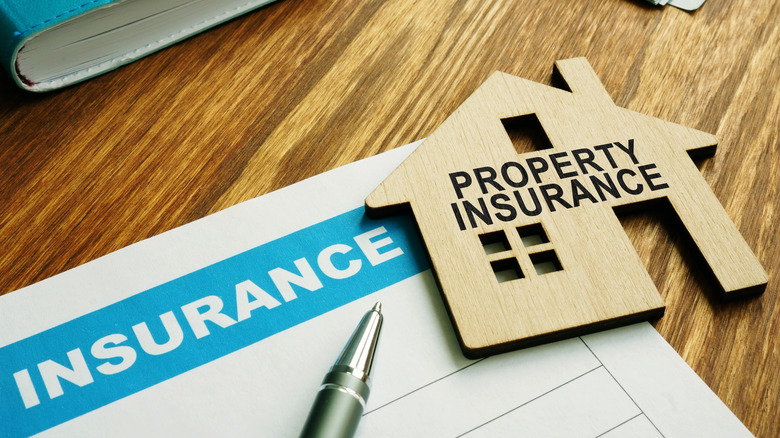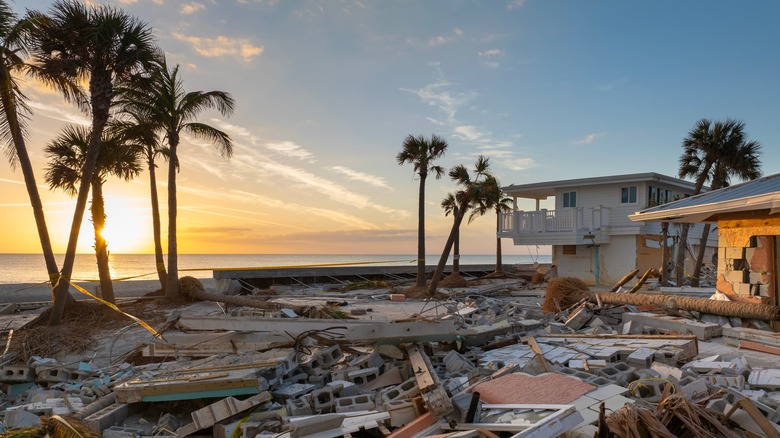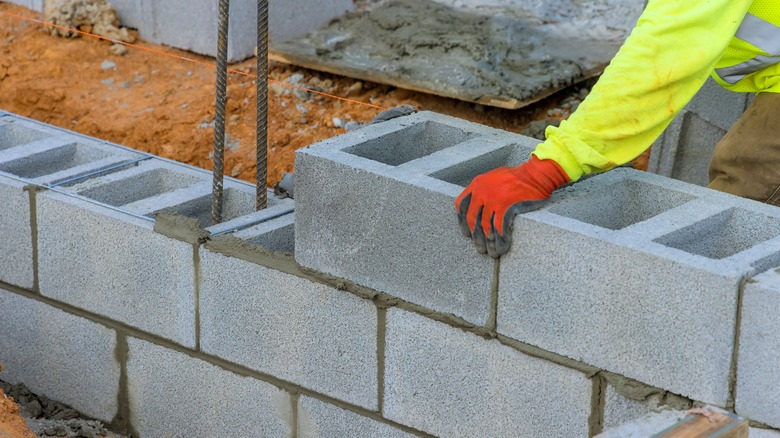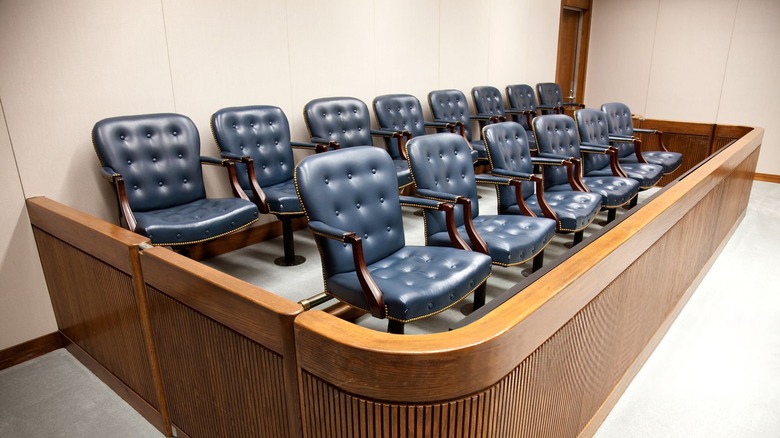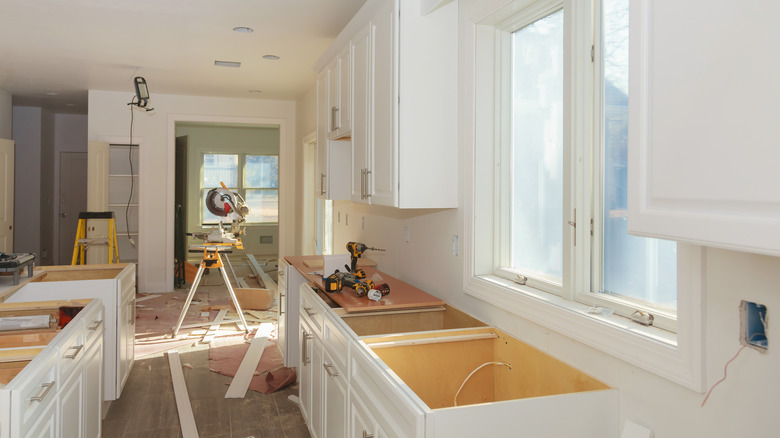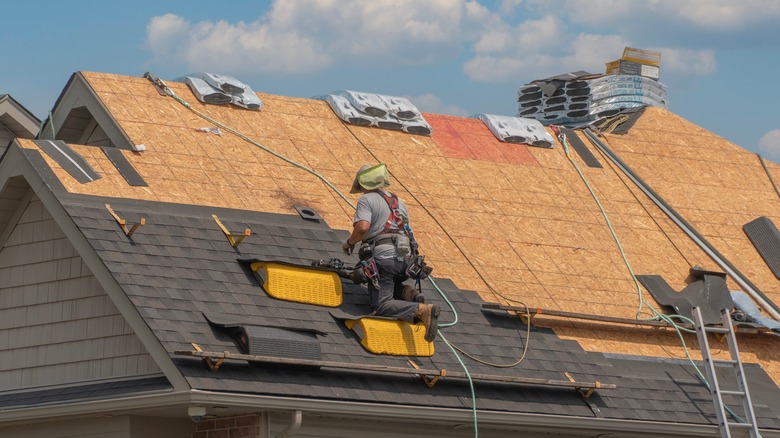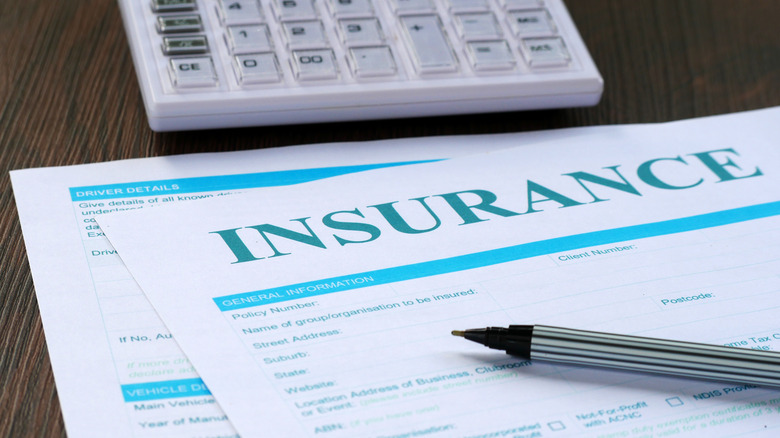Sneaky Reasons Your Property Insurance Rates Just Went Up
We may receive a commission on purchases made from links.
Most Americans have some property insurance, but only a small percentage actively monitor how their rates change over time. While some major events, such as a serious car accident or significant home damage, are widely acknowledged to hike rates, plenty of minor incidents can run up premiums behind the scenes. These seemingly insignificant tweaks aren't going to break the bank overnight, but their creeping costs can weigh into your monthly budgeting in the long run. Recognizing these sneaky reasons your property insurance rates are going up can help preserve your savings in the long run, keep routine costs under control, and increase your chances of catching these hidden adjustments before they take hold.
Unlike other forms of insurance, which pertain to something specific, property insurance is an umbrella policy, offering coverage for a multitude of assets. Generally speaking, property insurance policies can cover homeowners', renters', and car insurance, along with a variety of natural disaster claims such as earthquake or flood insurance. The purpose of property insurance is to conveniently roll all of the protection people need regarding their primary assets into a single policy. This convenience comes with a hefty price tag, especially since most lenders require borrowers to maintain some sort of insurance policy. Given the broad scope of these all-consuming policies, there are several ways your rates can sneak up without your knowledge. To help you save more money and keep your monthly costs manageable, let's look at some sneaky reasons your property insurance might go up.
Increasingly common severe weather
Weather plays a crucial role in the evolving premium costs of property insurance. These policies are hyper-specific about what climate-associated events they cover, given their unpredictability and damage potential. According to Investopedia, property insurance tends to account for damage caused by lightning, wind, smoke, fire, snow, ice, and hail. More extreme and unforeseeable weather incidents — including floods, tsunamis, nuclear fallouts, and even sewage-related issues — are generally not included. You can add those to the growing list of things insurance companies don't want to cover anymore. These non-covered events usually fall under the generic "acts of God" clause. Regardless of what weather-related instances a specific policy covers, the growing severity and commonality of severe weather events have been proven to bump up property insurance rates across the country.
A recent report by Yale University highlights how premiums — the monthly cost of holding a property insurance policy — are skyrocketing nationally. High-risk areas that receive a disproportionate amount of severe weather events, such as Texas, Louisiana, and Florida, are experiencing the brunt of these accelerating costs. According to the report, these elevated expenses stem from various related causes. First and foremost, fewer insurance companies remain active in high-risk regions due to surging operating costs. The knock-on effects of this evaporation of coverage options are a decrease in policy quality and rising expenses. Unfortunately, severe weather doesn't have to strike your house specifically for your rates to go up. As risks rise overall, policies are adjusted across the board.
Growing shortfall of skilled labor
The availability of skilled labor is another factor impacting property insurance premiums that is completely out of the control of policyholders. Beyond the costs of physical materials, the people hired to work on insurance-related construction projects are a huge financial burden for providers. Unfortunately, a widening gap between open skilled labor positions and available, capable employees is driving up wages, supply chain expenses, and other related costs. These higher operational fees force construction companies, a key variable for property insurance companies' budget calculations, to raise their prices. Thus, property insurance premiums go up, too.
Despite active federal attempts to reduce this shortage, Georgetown University projects this skilled labor gap will only worsen over time, further weighing on insurance premiums. From now until 2032, experts project around five million more skilled laborers to retire than those entering the workforce, widening the already stretched labor shortfall. At the same time, the country is anticipated to absorb nearly 700,000 positions demanding a post-secondary degree. This exacerbates the problem by pulling potential candidates for the skilled jobs toward other positions.
Rising cost of building materials
Construction is one of the largest expenses for insurance companies offering homeowners' insurance and renters' coverage due to the sheer cost of removal, remodeling, remediation, and rebuilding required following significant damage or loss. As a result, property insurance premiums, including homeowners' and renters' policies, are heavily influenced by the cost of repairing or replacing a home or apartment. Without your awareness, the steadily rising cost of building materials is a sneaky way your monthly payments could rise. Over the past few years, building materials have spiked in value due to a costly combination of supply chain disruptions, trade barriers, and general inflation. That's just one of the many ways new tariffs will impact your family's budget.
While the U.S. rate of inflation is aimed at 2% annually, the cost of construction materials is moving at a much faster pace. According to The Home Depot, materials are projected to rise between 5% and 7% over the next year. More specifically, furnishing, plastics, wood, and composite materials are expected to increase by a similar 5%. The accelerating rate of inflated prices has been slowing since post-pandemic records, although they're still outpacing general inflation. One of the consequences is a steady rise in property insurance costs as providers attempt to maintain their profit margins in an inflationary industry.
Poor credit score
People are generally aware of how their credit score can affect their ability to borrow money or open a line of credit. What's less widely known is how this figure can boost property insurance premiums. In the same way banks or lending institutions assess their assumed risk by looking at a borrower's credit score, insurance companies use this number to gauge their risk potential. Typically, the worse the credit score, the higher the monthly insurance premium. NerdWallet actually conducted a nationwide review to determine just how much of an impact this rating has on property insurance expenses. The results are shocking.
According to the analysis, an individual with a good credit score — judged to be between 690 and 719 — pays an annual premium of about $2,110. That yearly cost skyrockets by more than 71% for an individual with poor credit, anything below 630. On average, policyholders in this territory are getting slapped with $3,620 annual coverage fees, more than $1,500 higher than if they had a good credit score. NerdWallet acknowledges that every property insurance company determines its own definitions of "poor" and "good" credit ratings, but the influence remains. Given that nearly a quarter of people haven't checked their credit score in a year, this could be a surprise source of higher premiums for most people. Turns out that looking at the best ways to strengthen your credit score can actually save you money on property insurance.
Minor traffic infractions
Most people are perfectly aware of how a car accident can spike their insurance rates, but fewer are aware of more subtle causes of premium hikes. In reality, you don't have to get into an accident for your car insurance rates to increase. Something as seemingly unrelated as a minor traffic infraction can result in a boost to your overall property insurance. While a single instance of a major traffic violation, such as driving while under the influence, is enough to bump up your costs, smaller infractions often take time to pile up. Usually, the more frequent the minor incidents, the more severe the financial repercussions.
According to Experian, seemingly insignificant moving violations, such as failing to provide proper documentation or forgetting to wear a seatbelt, can spike monthly premiums by around 6% each. The company also notes that first-time offenders aren't automatically safe from a sneaky rise in premiums. One report found that a single speeding ticket resulted in a 10% increase in monthly costs for policyholders with a clean record up until that point. Regardless of your driving history, obeying all traffic regulations can help keep your property insurance policies in a manageable territory.
Recouping insurance losses
At times, some insurance companies will make a "catastrophe load" calculation to determine how much premiums will have to be raised to recoup losses from a major catastrophe. This analysis can be triggered by a single, extremely costly event or a series of occurrences adding up over time. The effect is the same: Insurers attempt to recoup losses by offsetting their expenses with elevated costs to policyholders, usually through raised premiums. Unfortunately, the "catastrophe load" of the insurance sector has been rising exponentially. In 2024, the last year for which data is available, total insured losses reached a staggering $145 billion, according to the Insurance Information Institute, placing significant financial pressure on insurance providers.
Generally, a "catastrophe" in this context is defined as an event, either man-made or naturally occurring, that costs insurance companies a minimum of $25 million, results in 50 injuries, causes 10 deaths, or forces 2,000 claims. Over the years, these events have been occurring at an alarming rate, burdening insurance companies, which are eager to offload those newfound costs onto normal people. Some of the most common culprits of these costly events are hurricanes, tornadoes, wildfires, and earthquakes. Although policyholders in affected areas see higher premium spikes, increases can happen across the country to help a company recover losses.
Increasing liability claims
Among the most opaque causes of higher property insurance rates is rising liability claims. Over the years, juries in the U.S. have been awarding plaintiffs higher compensation. This means insurance companies found liable have been forced to cough up more and more money in damages, changing their risk calculations. The phenomenon known as social inflation describes when liability claims against insurance entities increase at a quicker pace than what economic factors can account for. Other countries, such as Canada, the United Kingdom, and Australia, experience this social effect, but it's most prominent in the U.S., where juries determine damage amounts and tort law leans in favor of policyholders.
According to a study by the Swiss Re Institute, the rising legal costs for insurance companies have expanded liability claims by 57% over the past 10 years alone. As with other expenses, these elevated legal costs get passed on from the insurance companies to customers. This social effect seems to be picking up steam, too. The Rand Institute found that the amount plaintiffs were awarded for insurance-related damages grew by 7.6% annually over the course of a decade.
Making upgrades
Generally, making improvements to a property is viewed as a positive, especially from a financial perspective. There's a widespread perception that investing in a home or apartment's aesthetic appeal or structural integrity only has positive fiscal outcomes. While these upgrades can boost a property's curb appeal and resale value, these changes can also raise your insurance premiums. Yes, that seems completely unfair! However, it makes more sense when realizing how improvements can increase your policy's risk profile in the eyes of insurance companies.
Broadly speaking, a more valuable property demands better insurance coverage, resulting in a higher premium. For example, expanding a property's square footage with a porch or garage means more space has to be covered in case of damage or loss. The same is true when looking at automobile insurance. Whether you're repairing a vehicle or swapping out the entire engine, improvements tend to adjust the risk calculations. That's why it's important to check with your property insurance provider before making these adjustments to see how your premium might change. Generally, don't waste your money on upgrades if you're selling your home or if you're attempting to keep your insurance rates low.
Lapsed coverage
A lapse in coverage occurs when a policyholder fails to maintain coverage for any number of reasons. This could happen from forgetting to reenroll in coverage during an annual signup period, failing to make a sufficient or timely premium payment, or even a loss of eligibility. Regardless of the cause, lapsed coverage can open you up to unforeseen property insurance rates. These hidden costs can come in the form of one-time penalties or policy adjustments. While an unfortunate financial hit, the single fee is the ideal outcome. Most of the time, insurance companies allow you to reenroll in a similar policy but at a higher rate.
You can usually only lock in a price when officially remaining within a policy. Even a short lapse in coverage that you catch and rectify quickly can result in higher premiums. Believe it or not, this isn't a reflection of greedy insurance companies looking for any way to pull a fast one over their customers. Lapses in coverage can cause an individual to appear riskier to cover, resulting in costlier coverage. An immediate and unforeseen boost in premiums is bad, but the worst-case scenario is having to cover damages out of pocket when uninsured. The average American spends a lot on healthcare already. You should avoid raising those expenses when possible.
Reinsurance costs
The insurance industry is comprised of more than a single layer of providers. Many insurance companies are further insured by larger entities, creating a multitiered system of coverage. This matrix of insurers is another hidden way your property insurance premiums can rise over the years, mainly through a process known as reinsurance. This occurs when insurance companies offset a portion or the entirety of their risks to another, usually larger insurance company. Over the past few years, growing reinsurance costs have been shown to trickle down to individual policyholders. This creates a snowball effect of rising costs that tend to land heaviest on households in the form of a higher annual premium.
The National Bureau of Labor Statistics looked at more than 47 million property insurance policies to determine the impact of reinsurance. According to its research, the average premium exploded from $1,902 to $2,530 within a matter of three years. That 33% increase represents a national average, although states with more severe weather and more integrated health insurance systems saw even more dramatic premium growth. The bureau's research demonstrates how the insurance coverage burden is often shared among various providers, resulting in a rising tide of premium costs.
Aging roof
With the average roof lasting between 25 and 50 years and costing $9,500 to repair, most homeowners and renters don't pay much attention to this crucial part of their property's condition, value, and insurance costs. Insurance companies, which are run on highly specific actuary tables, risk assessments, and profit-loss calculations, track various components of a policyholder's property to determine an appropriate rate. As one of the most expensive components of a building and one of the most susceptible to damage, a roof's age and condition are closely monitored by property insurance providers. Every policy provider maintains proprietary calculations for determining how roof ages affect premiums, but age tends to drive up costs.
According to 44 Roofing, a roof that's two decades old can hike up property insurance premiums by 50%. The premium surcharge drops to between 5% to 15% for a roof around the 15-year mark. The company notes that different types of roofs have varying impacts on a policyholder's monthly property insurance costs over time. For example, metal roofs, which can last twice as long as asphalt iterations, usually receive better outcomes. In other words, a home with a more durable roof will see less of a negative impact on its premiums throughout the decades.
Past claims
Ironically, property insurance can sneak up based solely on the number of claims you make. Policyholders often assume that staying ahead of issues, maintaining transparency about damage, and generally being proactive would reflect positively on their policy. In truth, this aboveboard approach can drive up premiums by increasing an insurance company's risk assessment of an individual. Providers not only track the severity but also the frequency of claims. The more reports associated with your policy, the greater the company's perceived risk and projected costs. Instead of assuming these heightened expenses, companies offset them by raising annual premiums.
In general, it's advisable to skip making claims on small issues that don't require too much personal cost to address and that don't involve the fault of third parties. The amount of money offered based on your policy, if any amount is rewarded, could be offset in the long run by the amount your premium rises based on repeated claims. Don't let this reality scare you from making claims in general, as that would nullify the point of property insurance altogether. Filing too many minor claims can have other negative ripple effects, other than higher premiums. An insurer may determine a policyholder is too big a risk and cancel coverage outright or block renewal attempts. Providers that offer perks for minimal or no claims within certain periods could revoke those benefits, pulling some potential financial advantages.
Moving to a new area
Property insurance isn't only a reflection of your personal risks; it's also indicative of the hazards in your environment. Beyond catastrophic events, there's a common misconception that insurance companies only look at variables under the control of a policyholder, such as a history of incidents, personal behavior, and other measurable risks. However, insurance companies take various factors about your surroundings into account. More specifically, the average crime rates in the vicinity of where you live and work can influence how much you're paying for property insurance, including home and car insurance. Thus, moving to an area with even slightly higher property-related crime, such as vandalism or theft, could ramp up your rates without your immediate knowledge.
This isn't a reflection of anything you've done; it's simply a recalculation by the insurance provider of their increased risk. For example, a higher rate of vehicle theft in your new neighborhood raises the chances of your car falling victim to this crime. In turn, that makes it more likely your insurance company will have to cover such an event. The result is a higher premium to mirror the additional risk. The opposite can also be true: Moving to an area with lower crime rates can alleviate your premiums.
